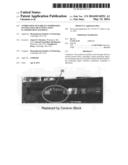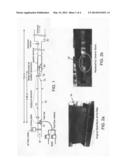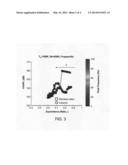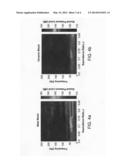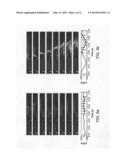Patent application title: Combustion Instability Suppression System Using Heat Insulating Flameholding Material
Inventors:
Ahmed F. Ghoniem (Winchester, MA, US)
Santosh Janardhan Shanbhogue (Watertown, MA, US)
Seunghyuck Hong (Cambridge, MA, US)
Assignees:
Massachusetts Institute of Technology
IPC8 Class: AF23M2320FI
USPC Class:
431114
Class name: Combustion with means attenuating sound or pulsation
Publication date: 2014-05-15
Patent application number: 20140134551
Abstract:
Combustor. The combustor includes a duct through which an air/fuel
mixture flows, including a flame-anchoring region. An insulating material
is located proximate the flame-anchoring anchoring region whereby
combustion instability is decreased.Claims:
1. Combustor comprising: a duct through which an air/fuel mixture flows
including a flame-anchoring region; and an insulating material located
proximate the flame-anchoring region whereby combustion instability is
suppressed.
2. The combustor of claim 1 wherein the duct includes a converging region followed by a step expansion region serving as the flame-anchoring region.
3. The combustor of claim 1 wherein the insulating material is a ceramic block.
4. The combustor of claim 2 wherein the duct further includes a constant area region between the converging region and the step expansion region.
Description:
[0001] This application claims priority to provisional application Ser.
No. 61/623,177 filed on Apr. 12, 2012, the contents of which are
incorporated herein by reference.
BACKGROUND OF THE INVENTION
[0002] This invention relates to combustion instability in combustors and more particularly to structure within the combustor selected to suppress combustion instability.
[0003] Combustion instability has been one of the most critical phenomena encountered during the development of gas turbine combustors used for propulsion and power generation as well as thrust augmenters, domestic and industrial burners and rocket engines. Because of significant pressure and flow oscillations, these instabilities may cause flame extinction, flashback, structural vibration, significant acoustic noise and even structural damage. As such, in order to develop high efficiency, low emission and compact combustors capable of stable operation over a wide range of operating conditions, it is necessary to formulate control strategies that can mitigate instabilities down to acceptable levels if not eliminating them completely. Passive strategies are preferable; they are less expensive and likely to be more robust.
[0004] It is an object of the present invention to demonstrate that the use of low heat conducting materials, also called heat insulating material, located in the flame-anchoring region within a combustor provides passive dynamics suppression over a wide range of operating conditions.
SUMMARY OF THE INVENTION
[0005] The combustor according to the invention includes a duct through which an air/fuel mixture flows, including a flame-anchoring region. An insulating material is located proximate the flame-anchoring region whereby combustion instability is suppressed. In a preferred embodiment the duct includes a converging region followed by a step expansion region serving as the flame-anchoring region. A suitable insulating material is ceramic block. The duct may also include a constant area region between the converging region and the step expansion region.
BRIEF DESCRIPTION OF THE DRAWING
[0006] FIG. 1 is a schematic illustration of a backward-facing step combustor according to an embodiment of the invention.
[0007] FIGS. 2a and 2b are illustrations or an original steel block (2a), and a ceramic block (2b).
[0008] FIG. 3 is a graph of overall sound pressure level for a propane/air flame as a function of equivalence ratio demonstrating the effect of an insulating material near the flame-anchoring region on combustion instability.
[0009] FIGS. 4a and 4b are sound pressure spectrum level maps as a function of equivalence ratio for (a) when the steel block is used at the step, and (b) when the ceramic block was used at the step.
[0010] FIGS. 5a and 5b are flame chemiluminescence image sequences for (a) when the ceramic block was used at the step and (b) typical unstable operating mode observed when the stainless steel block is used.
DESCRIPTION OF THE PREFERRED EMBODIMENT
[0011] A schematic illustration of the backward-facing step combustor system 10 that uses a sudden expansion to anchor the flame is shown in FIG. 1. The combustor 10 consists of a stainless steel duct 12 with, in an exemplary embodiment, a rectangular cross section 40 mm high and 160 mm wide. An air inlet is choked by a choke plate 14. At a distance of 0.5 m downstream from the choke plate 14, a 0.2 m long ramp 16 contracts the channel height from 40 mm to 20 mm, followed by a 0.2 m long constant-area section 18 that ends with a sudden expansion 20 back to 40 mm. The step height is 20 mm. Secondary air may be injected approximately 12 mm upstream of the backward facing step 20 from 12 holes having a diameter of approximately 0.5 mm drilled in a spanwise direction. The overall length of the combustor in this embodiment is 5 m. Circular exhaust pipe 22 comprises the last 3.0 m of the system.
[0012] With reference to FIGS. 2a and 2b, two different materials with distinct thermal conductivities were used near the flame anchoring region 20 (at the dump plane). FIG. 2a shows as original steel block 24 used in experiments. FIG. 2b shows a ceramic block 26 used in other experiments to be discussed below. These materials were located at the step expansion 20 in FIG. 1.
[0013] FIG. 3 shows the results of experiments conducted on the system disclosed herein. FIG. 3 shows the overall sound pressure level as a function of equivalence ratio for a propane/air mixture. Both in the case of using a steel block and using a ceramic block, the equivalence ratio was swept from rich to lean conditions. When the ceramic block 26--which is an insulating material--was used, the combustor system 10 did not transition to an unstable mode at all. To the contrary, the combustor 10 exhibited strong instability associated with the 40 Hz acoustic mode (see FIG. 4) for a range of equivalence ratio when the steel block 24--a material with high conductivity--was used. The sequences of flame chemiluminescence images at equivalence ratio of 0.85 for each case are shown in FIG. 5. In the case where the ceramic block was used (FIG. 5a), the flame convoluted around a vortex during the cycle while it remains attached to the step. With the steel block, the combustor exhibited strong oscillation at approximately 40 Hz with flame flashback during the part of the instability cycle as shown in FIG. 5b.
[0014] The simple, passive control strategies disclosed in this application are clearly desirable because of their minimal complexity. While active combustion control strategies are able to suppress thermoacoustic instabilities in premixed combustors by disrupting the coupling mechanisms that support these instabilities by using an actuator that modulates the fuel or airflow rate, these strategies require high cost, high speed actuators and add significant complexity to the design of combustors.
[0015] The inventors have demonstrated that replacing the combustor section near the flame-anchoring region with materials made of a high heat insulating capability is simple and promising for effective suppression of instability in a passive system.
[0016] It is recognized that modifications and variations of the invention will be apparent to those of ordinary skill in the art, and it is intended that all such modifications and variations be included within the scope of the appended claims. These include, but not limited to, combustion tunnels with axisymmetric cross section with overall geometric features similar to those described in this invention.
User Contributions:
Comment about this patent or add new information about this topic:

